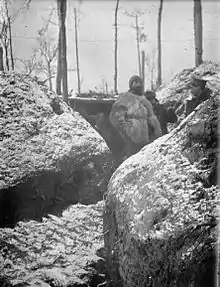| 1st Cavalry Brigade | |
|---|---|
| Active | 1815 1899–1902 1914–1919 |
| Country | |
| Branch | |
| Type | Cavalry |
| Size | Brigade |
| Part of | 1st Cavalry Division (World War I) |
| Engagements | Napoleonic Wars |
| Commanders | |
| Notable commanders | Lord Edward Somerset Baker Russell John French, 1st Earl of Ypres Charles James Briggs Horace Sewell[1] |
The 1st Cavalry Brigade was a brigade of the British Army. It served in the Napoleonic Wars (1st Household Cavalry Brigade), the Anglo-Egyptian War (1st (Heavy) Cavalry Brigade), the Boer War and in the First World War when it was assigned to the 1st Cavalry Division.
Prior to World War I the brigade was based at Aldershot in England and originally consisted of three cavalry regiments, and a Royal Engineers signal troop. After the declaration of war in August 1914, the brigade was deployed to the Western Front in France, where an artillery battery joined the brigade the following September and a Machine Gun Squadron in February 1916.[2]
One of the brigade's early battles was the action at Néry on 1 September 1914 when, acting alone, the brigade defeated the German 4th Cavalry Division. As a result of this action three men from the artillery battery – Captain Edward Bradbury, Sergeant-Major George Dorrell and Sergeant David Nelson – were awarded the Victoria Cross.
History
Napoleonic Wars

From June 1809, Wellington organized his cavalry into one, later two, cavalry divisions (1st and 2nd) for the Peninsular War.[3] These performed a purely administrative, rather than tactical, role;[4] the normal tactical headquarters were provided by brigades commanding two, later usually three, regiments.[5] The cavalry brigades were named for the commanding officer, rather than numbered.[lower-alpha 1] For the Hundred Days Campaign, he numbered his British cavalry brigades in a single sequence, 1st to 7th.[lower-alpha 2] The 1st Cavalry Brigade consisted of:
As the majority of the brigade consisted of Household Cavalry regiments, it was known as the 1st (Household) Cavalry Brigade .
Anglo-Egyptian War
- Household Cavalry Composite Regiment (1 Squadron each from the 1st Life Guards, 2nd Life Guards and Royal Horse Guards)
- 4th Dragoon Guards
- 7th Dragoon Guards
Second Boer War
The brigade was reformed for the Second Boer War. During the Battle of Paardeberg, the brigade commanded:[13]
- Household Cavalry Composite Regiment
- 10th Royal Hussars
- 12th Royal Lancers
- Q, T and U Batteries, Royal Horse Artillery[14]
Following the end of the Second Boer War in 1902 the army was restructured, and the 1st Cavalry Brigade was established at Aldershot (South Cavalry Barracks) attached to the 1st Army Corps.[15]
First World War

- 2nd Dragoon Guards (Queen's Bays)
- 5th (Princess Charlotte of Wales's) Dragoon Guards
- 11th (Prince Albert's Own) Hussars
- 1st Signal Troop, Royal Engineers
- I Battery, Royal Horse Artillery from 17 September 1914
- 1st Cavalry Brigade Machine Gun Squadron Machine Gun Corps[2]
Commanders
The commanders of the 1st Cavalry Brigade during the First World War were:[16]
- Brigadier-General C. J. Briggs (At mobilization)
- Lieutenant-Colonel T. T. Pitman (7 May 1915 - acting)
- Brigadier-General E. Makins (15 May 1915)
- Brigadier-General H. S. Sewell (16 April 1918)
See also
Notes
- ↑ This could be a source of confusion as brigades acquired new commanders, or they moved between brigades. For example, Fane's Brigade became De Grey's Brigade from 13 May 1810 when Henry Fane went to Estremadura;[6] De Grey's Brigade was broken up 29 January 1812.[7] On 20 May 1813, Fane took over Slade's Brigade;[8] the second Fane's Brigade was unrelated to the original one although coincidentally, and to add to the potential confusion, the 3rd Dragoon Guards served in both.[9]
- ↑ The British cavalry included five regiments of the King's German Legion.[10][11]
References
- ↑ "World War One — Part 1". 1st Queens Dragoon Guards. Archived from the original on 17 July 2012. Retrieved 30 August 2012.
- 1 2 "1st Cavalry Division". The Long Long Trail. Retrieved 30 August 2012.
- ↑ Reid 2004, p. 79
- ↑ Haythornthwaite 1990, p. 103
- ↑ Reid 2004, p. 75
- ↑ Reid 2004, p. 80
- ↑ Reid 2004, p. 83
- ↑ Reid 2004, p. 85
- ↑ Reid 2004, pp. 79–86
- ↑ "The Anglo-Allied Army at napoleonic-literature.com". Archived from the original on 17 July 2012. Retrieved 21 March 2013.
- ↑ "Wellington's Army in 1815". Retrieved 25 August 2014.
- ↑ "Wellington's Army in 1815". napolun.com. Retrieved 31 August 2012.
- ↑ "Battle of Paardenburg". British Battles.com. Retrieved 30 August 2012.
- ↑ Clarke 1993, p. 55
- ↑ "Naval & Military intelligence - The 1st Army Corps". The Times. No. 36892. London. 7 October 1902. p. 8.
- ↑ Becke (1935), p. 2.
Bibliography
- Becke, Major A.F. (1935). Order of Battle of Divisions Part 1. The Regular British Divisions. London: His Majesty's Stationery Office. ISBN 1-871167-09-4.
- Clarke, W.G. (1993). Horse Gunners: The Royal Horse Artillery, 200 Years of Panache and Professionalism. Woolwich: The Royal Artillery Institution. ISBN 09520762-0-9.
- Haythornthwaite, Philip J. (1990). The Napoleonic Source Book. London: Guild Publishing.
- Reid, Stuart (2004). Wellington's Army in the Peninsula 1809–14. Volume 2 of Battle Orders Series. Oxford: Osprey Publishing. ISBN 1-84176-517-1.
- Smith, Digby (1998). The Greenhill Napoleonic Wars Data Book. London: Greenhill Books. ISBN 1-85367-276-9.
External links
- Baker, Chris. "The 1st Cavalry Division in 1914-1918". The Long, Long Trail. Retrieved 24 June 2015.
- "1st Cavalry Division on The Regimental Warpath 1914 - 1918 by PB Chappell". Archived from the original on 8 January 2008. Retrieved 2 August 2013.